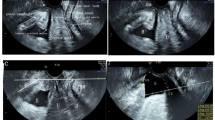Abstract
The objective was to determine whether vaginal topography accurately predicts the location of the pelvic viscera on fluoroscopy in women with pelvic organ prolapse. Eighty-nine women undergoing preoperative evaluation for reconstructive pelvic surgery at a tertiary care referral practice formed the study population. Each woman completed a comprehensive urogynecologic history and physical examination, which included a quantified (POP-Q) assessment of her vaginal topography, as described by Bump et al. In addition each woman underwent pelvic floor fluoroscopy (PFF). Visceral sites were selected which corresponded clinically to the vaginal sites measured by the POP-Q. The most dependent portion of the bladder, small intestine, rectum and urethrovesical junction was measured. Twenty-five (28%) women had stage II prolapse, 34 (38%) had stage III prolapse, and 28 (32%) had stage IV prolapse. The remaining 2 women were symptomatic, with stage I prolapse. For the entire study population there was no correlation between the fluoroscopic position of the small bowel and/or rectum and any apical or posterior wall POP-Q site (C, Ap or Bp). There was no correlation with the fluoroscopic position of the UVJ at rest or with straining and the corresponding POP-Q site (Aa). The fluoroscopic position of the most dependent portion of the bladder correlated only modestly with the upper (Ba,ρ=0.51) and lower Aa,ρ=0.68) anterior vaginal wall POP-Q sites. In women without prior surgery (n=33) there was only modest correlation between the fluoroscopic position of the bladder and the corresponding POP-Q site (Aa,ρ=0.71). In this unoperated subpopulation there was no correlation with PFF and any other POP-Q site. In women who had undergone prior hysterectomy (n=25) or hysterectomy with anterior and/or posterior colporrhaphy (n=17), there was only a modest correlation of the most dependent portion of the bladder and the upper anterior vaginal wall site (Bb,ρ=0.67 andρ=0.55, respectively). It was concluded that vaginal topography does not reliably predict the position of the associated viscera on PFF in women with primary or recurrent pelvic organ prolapse.
Similar content being viewed by others
References
Olsen AL, Smith VJ, Bergstrom JO, Colling JC, Clark AL. Incidence and clinical characteristics of surgically managed pelvic organ prolapse and urinary incontinence.Obstet Gynecol 1997;89:501–506
Bump RC, Mattiasson A, Bø K et al. The standardization of terminology of female pelvic organ prolapse and pelvic floor dysfunction.Am J Obstet Gynecol 1996;175:10–17
Kelvin FM, Maglinte DDT, Benson JT. Evacuation proctography (defecography): an aid to the investigation of pelvic floor disorders.Obstet Gynecol 1994;83:307–314
Brubaker L, Retzky S, Smith C, Saclarides T. Pelvic floor evaluation with dynamic fluoroscopy.Obstet Gynecol 1993;82:863–868
Author information
Authors and Affiliations
Additional information
EDITORIAL COMMENT: The authors seek to evaluate whether physical examination of vaginal prolapse using the POP-Q test correlates with fluoroscopic findings of visceral position. Surprisingly, little correlation is found, even in previously unoperated patients. One reason for this lack of correlation between the two modalities of evaluation may lie in the use of two different fixed points of reference: the POP-Q examination uses the hymen as the fixed point of reference, whereas the investigators chose to use the posterior edge of the femur as a fixed bony point of reference when evaluating pelvic floor fluoroscopy in the same patient. The lack of correlation between visual inspection of vaginal wall prolapse and what lies deep to that prolapse should not be used to invalidate the use of the POP-Q as a means to evaluate pelvic prolapse. Rather, the findings support the premise behind the ICS/AUGS/SGS committee on pelvic organ prolapse, specifically that clinical pelvic examination of the vaginal walls looks at surfaces only, and as such cannot determine what, if any, organ lies deep to that surface.
Rights and permissions
About this article
Cite this article
Kenton, K., Shott, S. & Brubaker, L. Vaginal topography does not correlate well with visceral position in women with pelvic organ prolapse. Int Urogynecol J 8, 336–339 (1997). https://doi.org/10.1007/BF02765592
Issue Date:
DOI: https://doi.org/10.1007/BF02765592




